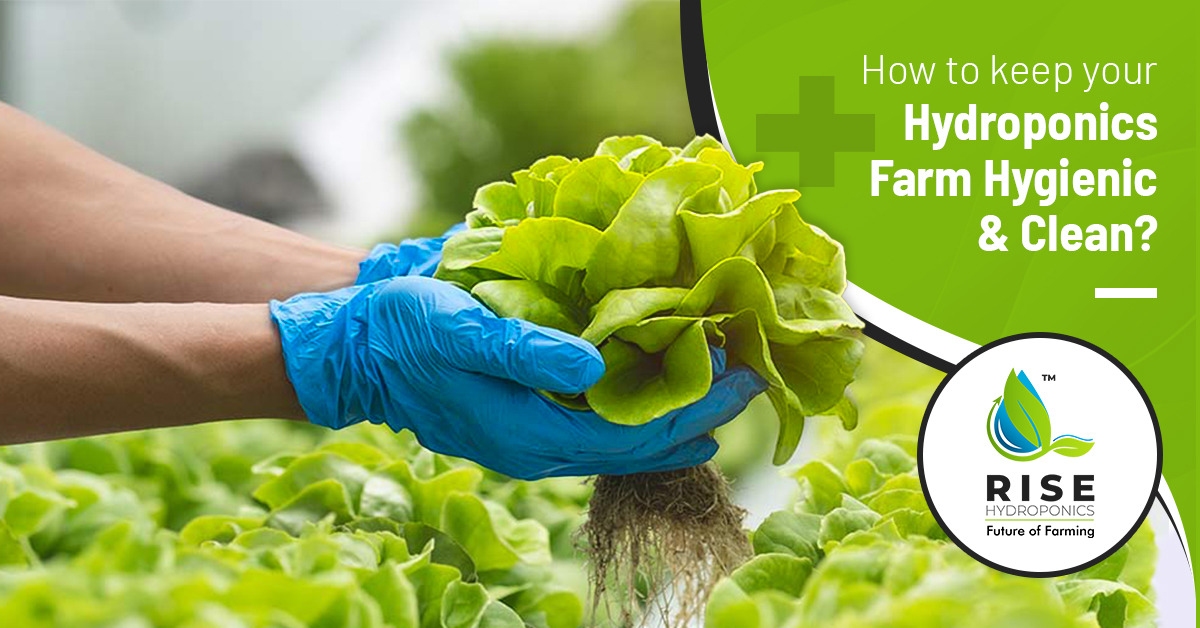Hydroponics Farming is literally Booming!
Hydroponics in India started taking its baby steps in 2010 and now in every state we can spot so many polyhouse structures dedicated to soil-less farming.It has shown impressive results in all these years and now hydroponics is finding favors of Farmers, Entrepreneurs and Government alike.But as we all know “With Growth comes New Challenges”. So, this time we have made a special blog that has a good dose of information and learnings collated by the team at Rise Hydroponics.
Oh Yes! Today’s blog discusses about the best and easy ways that Hydroponics farm owners can follow to keep their farms hygienic and clean.“Farm Hygiene” is the most crucial topic that usually takes a back seat and comes at the forefront only when crops face losses and farm productivity start falling.So, come let’s pick some speed and answer the most basic questions and then we’ll jump onto the Good Practices that can be followed for farm hygiene.
WHY IS FARM HYGIENE IMPORTANT?
Farm Owners invest nice amount of money into hydroponics farm setups.
Then they procure seedlings, get them placed in the appropriate sections and kickstart all the equipment.
All of us expect bumper crop growth and eventually aspire to make more profits.
But wait a second. Many a times, things don’t go as smooth as they sound.
It’s because just one mistake at your farm can make things go worst.
Here are the top 7 reasons on why farm hygiene is super important:
⦁ PESTS & DISEASES
These are the most common causes that lead to crop loss:
PESTS: Bugs, Insects, Caterpillars and flies.
PATHOGENS: Pathogens are organisms that cause diseases. Pathogens include bacteria, viruses, fungi, nematodes (small worm like animals), powdery moulds and mildew.
Even bacterial spots on leaves, fruits and vegetables are also visible to the naked eye.
⦁ IMPACTS PROFITABILITY
Bad Hygienic Conditions and Poor cleanliness impacts the productivity and profitability.
⦁ INCREASE IN EXPENDITURE
A lot of amount goes into expenditure on buying of pesticides that are sprayed to control pest infestations and its growth. This may appear to be a minor issue in initial days; but in longer term, your farm’s overall profits will start falling gradually. And so does the crop yield which too goes down.
⦁ WEEDS ACT AS HOST FOR DISEASES
Pests and Diseases come from weeds. Those weeds that exist in and around your greenhouse are the main growing areas for weeds. Weeds provide shelter and food for pests and act as a host for diseases.
⦁ CROP DEBRIS IMPACT NEW PLANTS
Crop Debris are discarded leaves, infected fruits and veggies and you must know that pest and diseases hold onto these crop debris for a long-long time. And eventually they can also infest onto new plants.
Leaving them on the floor will attract pests and other diseases on the litter and thus contamination to other healthy crops of your hydroponics farm.
⦁ SOIL & DIRT CARRY PATHOGENS
Dust and dirt on shoes when left unchecked, become powerful carriers of harmful micro-organisms and pathogens that impact plant growth. Even wind can blow dust that carries disease causing pathogens.
⦁ RAIN WATER IS NOT GOOD
Splashes of rain or the water from rain storms and even minor flooding are potential carriers of diseases.
Whoof! Looks like there are so many things to care about. Right?
But RELAX!
Rise Hydroponics and its teams will make it easy for you.
So, here we have the most special part of this blog:
17 BEST & SUPER USEFUL GUIDELINES FOR GOOD FARM HYGIENE OF HYDROPONICS GREENHOUSE
First things first, we must pay importance to loss minimization as far as possible.
Proper cleanliness will save you a lot of man hours and money.
Money that goes into hiring extra labor for cleaning and spreading of pesticides.
⦁ ASSIGN RESPONSIBILITY FOR REPORTING
Decide upon the cleaning tasks and assign the best men for this job. Then for keeping up with accountability, the farm owners must lay down a basic procedure to be followed every day for upkeep, maintenance and cleaning of the Greenhouse. And consistent tracking must be performed on the basis of reports, so as to keep things under control.
⦁ CHECK NEW SEEDLINGS
Seedlings must be assessed before planting them. Since seedlings are brought from a nursery or your own dedicated growing space, so they are also a potential source of pest and disease, if left unchecked for a long time.
⦁ REMOVE CROP DEBRIS:
Old Plants, Foliage and other infected plant material removed from a crop during its growing period are called as crop debris. These also include discarded fruits, leaves and old fruits left in the greenhouse. They must be removed/discarded from the greenhouse or else they provide refuge to a number of pests and diseases.
⦁ PLUCK THE WEEDS
The area around the greenhouse must be properly mowed and kept clean, so that weeds and its seedlings can be plucked out as soon as possible.
⦁ KEEP A BUFFER AREA AROUND EVERY GREENHOUSE
A 5-10 meters buffer area is also recommended around the greenhouse. This buffer area is the barren space in between the boundaries of polyhouse structure and the surrounding spaces. The Surroundings of the greenhouse must be kept free from weeds.
⦁ TOOLS
Instead of hands, one must use sharp tools to cut the infected parts and take them away for disposal. But you have to make sure that these tools must be disinfected everyday with ethyl alcohol, bleach or whichever disinfectant suits best for this purpose.
They must be cleaned and disinfected at regular intervals. Even their space for storage and maintenance must be kept hygienic.
⦁ DISINFECT THE WATER
Water must be disinfected before being flown to the plants. Some farms do treat the water with Chlorine, but we’ll suggest them to do routine monitoring of Chlorine levels and pH too. That’s why even disinfected water needs to be stored in a closed tank, in order to minimize the risk of debris and dust.
Water in recirculation also needs to be disinfected from time to time. Otherwise, any undetected infected plant can pass down a disease in the water running through the roots.
⦁ ROUTINE CLEANING OF STRUCTURE
Pests can easily hide and wait around the structure and its fittings. That’s why our experts always recommend farm owners to assign men for cleaning of the structural fittings.
⦁ FLOOR COVERINGS
Floor coverings of the greenhouse must be well maintained. They must be swept and washed at regular intervals.
⦁ EMPTY THE BINS DAILY
Bins must be kept inside the polyhouse, for discarding of waste plant materials, crop debris and must be emptied daily so as to avoid making them a breeding ground of pests.
⦁ WORKER & VISITOR HYGIENE
Clean clothes or single use disposables are recommended to ensure hygiene.
Disposable Gloves and Disposable paper “Lab Coats” have also gained wide popularity on hydroponics farms in India.
Clean Buckets should be made mandatory before being taken inside the polyhouse.
And yes, Tobacco consumption and smoking must be prohibited inside the greenhouse and also around the buffer zone.
Even farm owners and employees must wash their hands if they have smoked and only then they must be allowed to step inside the greenhouse.
⦁ DISEASED FOLIAGE
Diseased foliage, fruits and critically infected plants need to be removed from the greenhouse. This reduces the opportunity for diseases to spread onto any crop.
Place these discarded plant materials directly into bags or bins and take it out of the greenhouse.
⦁ PRUNING IS MUST
Pruning means removing those parts of plant that are not up to the mark or show signs of degradation. It is quite useful for maintaining air circulation within the crops. This method is also used to discard unmarketable fruits from the crops. It’s because pruning further helps in sustained crop growth and balanced yield.
⦁ START USING TEMPERATURE & HUMIDITY SENSORS
Temperature and Humidity sensors must be installed or used at every greenhouse. Humidity must be maintained as recommended by the agronomist or else too low or even too high humidity gives a suitable condition to pests and diseases to grow ahead.
⦁ ENSURE GOOD AIR CIRCULATION
Farms must have windbreaks and venting screens to slow down the air speed.
Pests like Whiteflies, Thrips and Aphids may fly or can be even carried along with speedy airflow.
Good air circulation ensures good plant health. Poor air circulation gives breeding ground to mildew and other harmful pests and diseases.
⦁ USE STICKY TRAPS
You can also place “Sticky Traps”. Traps of colors like yellow, blue and white, just because pests are attracted the most to these colors.
⦁ FOLLOW THIS SIMPLE WORK ORDER PLAN:
When checking for pests, wilting or diseases, this plan becomes the smartest choice to follow. It’s because pathogens from one polyhouse must never be taken to another polyhouse.
This plan goes as follows:
⦁ Work on the Cleanest Crop first.
⦁ Work on Youngest Crop first, and then
⦁ On the Most affected ones
These 21 tips will ensure good farm hygiene and cleanliness on your hydroponics farms and will save you a lot of time, efforts and money.
Now we’d just advise you to perform routine checking of plant diseases and check for any kind of abnormal plant growth.
EARLY DETECTION IS VERY CRUCIAL
We hope you enjoyed reading this blog dedicated to ensure farm hygiene for your hydroponics setup and these pointers and tips will come in handy for a long run.
If you wish to discuss more about hydroponics, then please feel free to contact us on our official email address or leave a comment below and we’ll get back to you within 24 hours.
Thanks for reading this blog.
Rise Hydroponics has more of such special blogs coming your way.
Stay Tuned for more.

